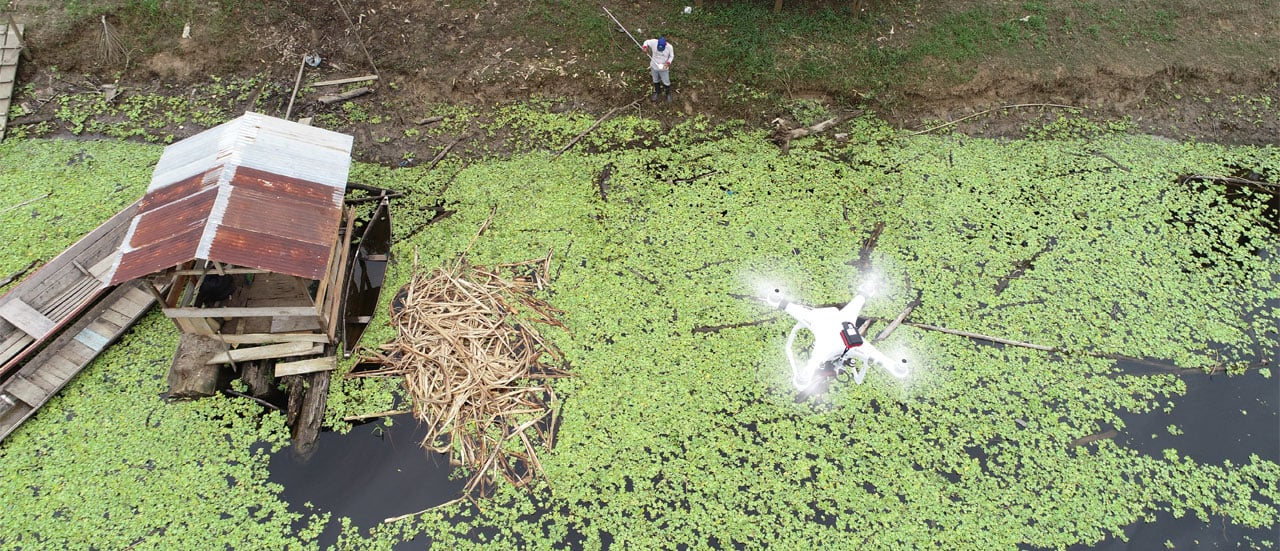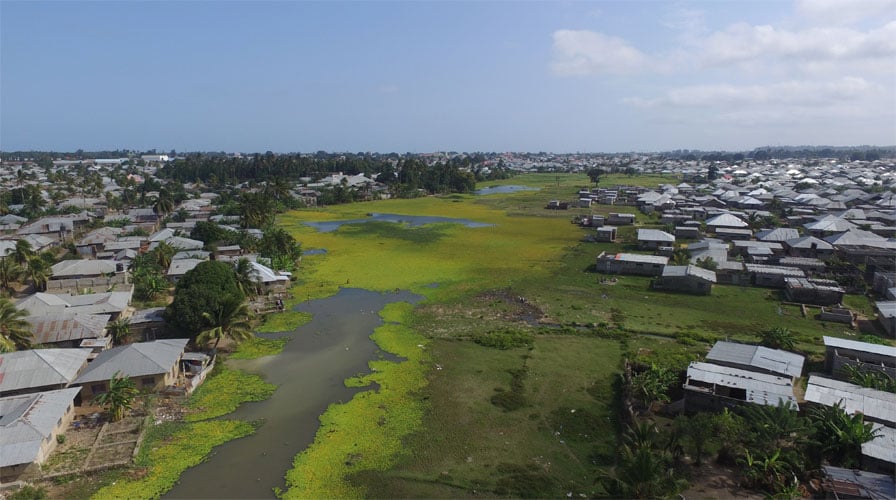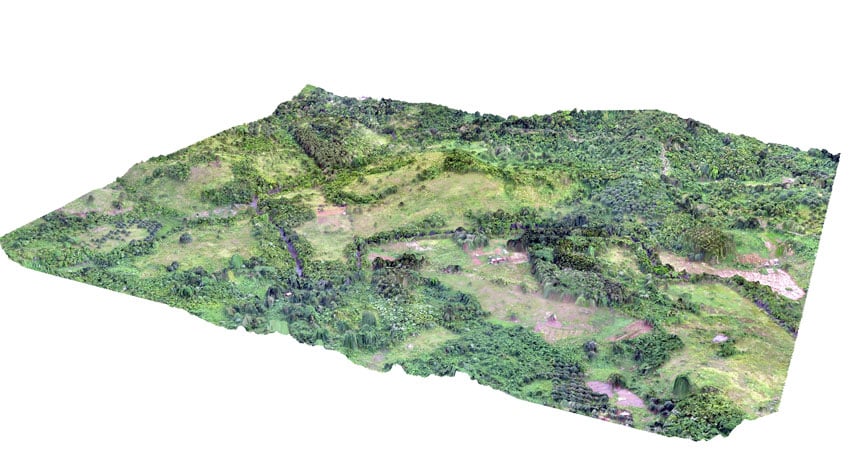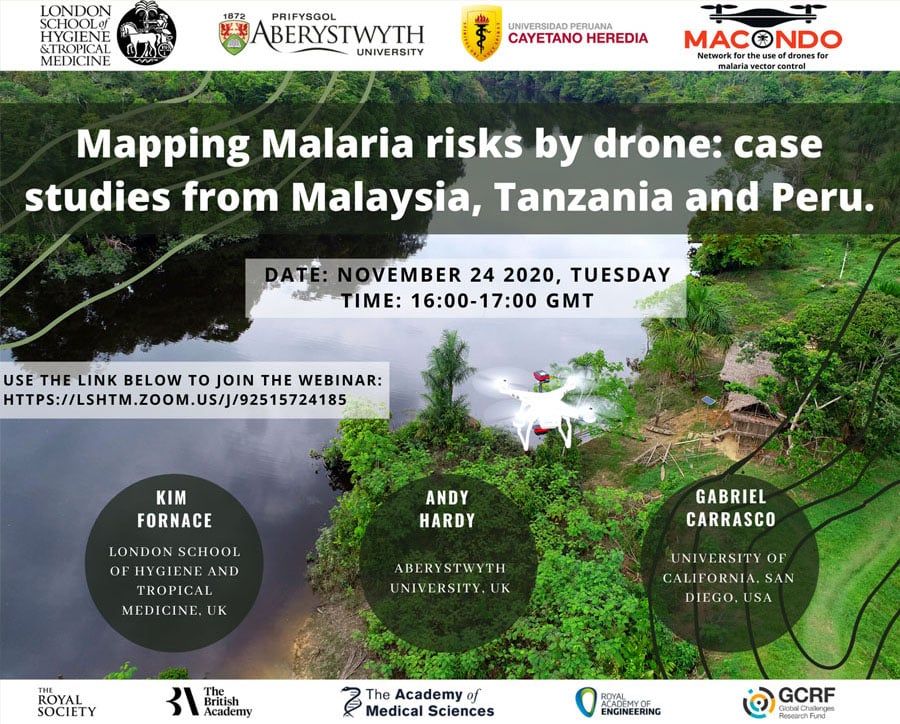We are a multidisciplinary team focused on the use of low-cost drones to collect high resolution imagery to support operational malaria vector programmes.
The network is jointly run by the London School of Hygiene and Tropical Medicine (UK) and Universidad Peruana Cayetano Heredia (Peru) with researchers working in South America, Asia and Africa.
To support the use of drones for vector control, we are developing guidelines, tutorials and protocols to collect and analyse aerial imagery.
Malaria control programmes rely on interventions targeting mosquito-breeding sites to reduce mosquito populations and malaria transmission. These approaches require precisely locating the water bodies and potential breeding sites. Low-cost drones represent a new potential source of data for mapping land use and identifying breeding sites. However, the use of drones for public health is still in its infancy and needs guidance on technical requirements and image analysis methods as well as the feasibility and acceptability of employing these methods in communities.
This collaborative network brings together experts to support the integration and evaluation of drone technology to support malaria vector control programmes. We are a multidisciplinary network of researchers using drones for malaria control and risk mapping in South America, Southeast Asia and sub-Saharan Africa. By developing guidelines for the use of drones and analysis of resulting imagery, we aim to overcome technical barriers for implementation.
- Development of guidelines and resources
-
We are assessing methods of analysing drone imagery (including manual digitisation, image segmentation approaches, automatic thresholding, automatic and manual generation of training data, application of machine learning/AI approaches). These are applied to different combinations of data collected, including visible, multispectral, thermal imagery and derived indices. We are comparing accuracy, costs, technical requirements and limitations for implementation and developing platforms to share materials.
- Community acceptability
-
Effective use of drones may be limited by community perceptions and acceptability. Public attitudes surveys will be conducted with community members to explore issues relating to land rights, technology use and permissions. Economic feasibility will be assess using a basic cost analysis comparing cost and accuracy of identification of habitats by aerial vs ground-based surveys. Based on these interviews, we will develop guidelines to assess socioeconomic barriers to drone implementation.
- Case study in the Peruvian Amazon
-
Using the Peruvian Amazon as a case-study, we are exploring the use of different sensors and analytical approaches to identify suitable water bodies for anopheline larvae. Amazon basin is a priority area for malaria control in the Americas and provides a unique ecological setting to assess a range of mosquito breeding sites (natural – artificial), forest coverage, hydrology profiles and malaria transmission.
Planned for 2020, this pilot study will be used to collect sample imagery and develop an operational workflow for data collection, including flight planning, immediate processing for data quality and identification of limitations in extreme weather conditions and difficult terrain.
Dionicia Gamboa, Msc, PhD
Associate Professor
Project PI. Associate Professor at the School of Science and Philosophy, Principal Researcher and Head of the Malaria Laboratory at the Instituto de Medicina Tropical Alexander von Humboldt, Universidad Peruana Cayetano Heredia.
Gabriel Carrasco, Msc, PhD(c)
Associate Researcher
PhD student in Global Health at University of California, San Diego (UCSD). Associate Researcher and Head of the Health Innovation Laboratory at the Institute of Tropical Medicine Alexander von Humboldt, Universidad Peruana Cayetano Heredia (UPCH). Visiting Researcher at the London School of Hygiene and Tropical Medicine (LSHTM), UK.
Manuela Herrera, Msc, PhD
Associate Researcher
Postdoctoral fellow Amazonia ICEMR / Universidad Peruana Cayetano Heredia. Associate Researcher at Instituto de Medicina Tropical Alexander von Humboldt, Universidad Peruana Cayetano Heredia.
Jan Conn, PhD
Professor
Professor, School of Public Health, Wadsworth Center, New York State Department of Health.
Andy Hardy, PhD
Lecturer
Lecturer in Remote Sensing and GIS, Department of Geography and Earth Sciences, Aberystwyth University.
Dr. Fe Esperanza Caridad Espino, MD PhD
Department of Parasitology
Department of Parasitology and National Reference Laboratory for Malaria and Parasitic NTDs, Research Institute for Tropical Medicine, Department of Health, Philippines.
Dalia Iskander
Teaching Fellow
Teaching Fellow Medical Anthropology, UCL Anthropology, University College London.
Amaziasizamoria Jumail
Researcher
Researcher, Danau Girang Field Centre, Malaysia.
MACONDO is developing resources to support planning and conducting drone flights, image processing and data analysis for researchers and control programmes. We will be uploading useful documents and guidelines to this website throughout 2020 so please check back for updates.
Sections will include:
- Guidelines for flying drones
- Image processing
- Data analysis
- External links
Malaria control programmes rely on interventions targeting mosquito-breeding sites to reduce mosquito populations and malaria transmission. These approaches require precisely locating the water bodies and potential breeding sites. Low-cost drones represent a new potential source of data for mapping land use and identifying breeding sites.
This webinar will present three case-studies using drones for malaria control and risk mapping in South America, Southeast Asia and sub-Saharan Africa and will explore the use of different sensors and analytical approaches to identify suitable water bodies for anopheline larvae.
This event will include short presentations from each speaker discussing on the framework of each case study. Presentations will be followed by an interactive discussion with the panelists and audience, addressing challenges and opportunities in the use of drones in malaria vector control programs in different ecological settings.
LSHTM and UPCH are co-hosting the MACONDO Workshop in Peru. A number of researchers working in drone imagery, spatial analysis and vector biology will present their work with opportunity for group discussion. The expected outcomes of the discussion are to identify the challenges and opportunities in the use of drones for VBD control strategies in different ecological settings. Workshop sessions will include:
- Elaboration of technical guidelines, methodologies and feasibility plans
- Operational workflow for data collection: methodologies of flights, type of imagery, photogrammetric routines (efficiency of processing, presence of artefacts)
- Image analysis and data process: manually digitalising, machine learning approaches
There are few openings available to participate. If you are interested to attend, please contact Kimberly.Fornace@lshtm.ac.uk or Marta.Moreno@lshtm.ac.uk.
The Monkey Bar Project, by LSHTM, has been running a research programme using drone technology to monitor the spread of malaria.
A study undertaken by LSHTM showed that bed nets treated with two chemicals reduced the prevalence of malaria by 44 per cent, compared to a standard bed net treated with the standard insecticide, pyrethroid.
Drones were used as part of research to map the breeding sites of mosquitoes.
Drones were used in a study aimed to find out more about ongoing malaria transmission in two different hotspots in the Peruvian and Brazilian Amazon.






